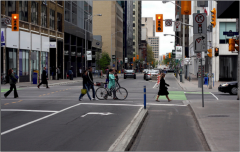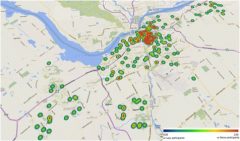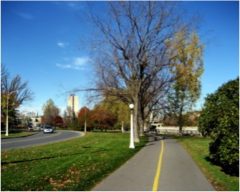About the Study
“The built environment is part of our physical surroundings and includes the buildings, parks, schools, road systems, and other infrastructure that we encounter in our daily lives.”
-Public Health Agency of Canada
Features of the built environment can influence physical health, mental health, and perceptions of safety.  Our study focused primarily on the features that relate to:
Our study focused primarily on the features that relate to:
- walkability (e.g., sidewalks, curb cuts, crosswalks, traffic density)
- bikeability (e.g., bike lanes, road markings, traffic density)
- recreational and green spaces (i.e., parks, sports fields, fitness facilities)
- outdoor lighting.
We wanted to know how these features influenced the health and safety of people with mobility restrictions, seniors, and parents with young children (under 5 years).
How did we do this?
This study had two components: (1) online survey and (2) focus group participation. The study was advertised to residents from all Ottawa neighbourhoods through poster advertisement, social media, print media, and City counsellor newsletters.
1. Online Survey
Over 400 Ottawa residents participated in the online survey (administered from January to March 2016)! The questions related to features of the built environment, health measures, perceptions of safety, socio-demographic status, and residents’ postal code. From the postal code data, we could determined the walkability, bikeability, traffic density, and urban greenness of each neighbourhood based on satellite imaging. We could them compare the two data sets using a variety of statistical methods including analysis of variance (ANOVA) to determine specific features of the built environment that influence physical and mental health, and perceptions of safety.

In which Ottawa neighbourhoods were our survey respondents living? — Thank you!
2. Focus Group Participation
Two focus groups were conducted in February 2016 with participants who identified as having a  mobility restriction, as a senior, or as a parent to young children. Participants were guided through an open discussion by six questions that explored built environment features as barriers or facilitators, as well as determined desired neighbourhood changes.These data were thematically analyzed.
mobility restriction, as a senior, or as a parent to young children. Participants were guided through an open discussion by six questions that explored built environment features as barriers or facilitators, as well as determined desired neighbourhood changes.These data were thematically analyzed.
These findings form the first attempt to characterize the relationship between the built environment and the health and safety of Ottawa-residents across the three subpopulations, and to identify the changes Ottawa-residents want to see implemented in their neighbourhoods. The use of both subjective and objective measures of the built environment, and our mixed-methods design provides greater insights and evidence necessary to inform policy directions and future research.